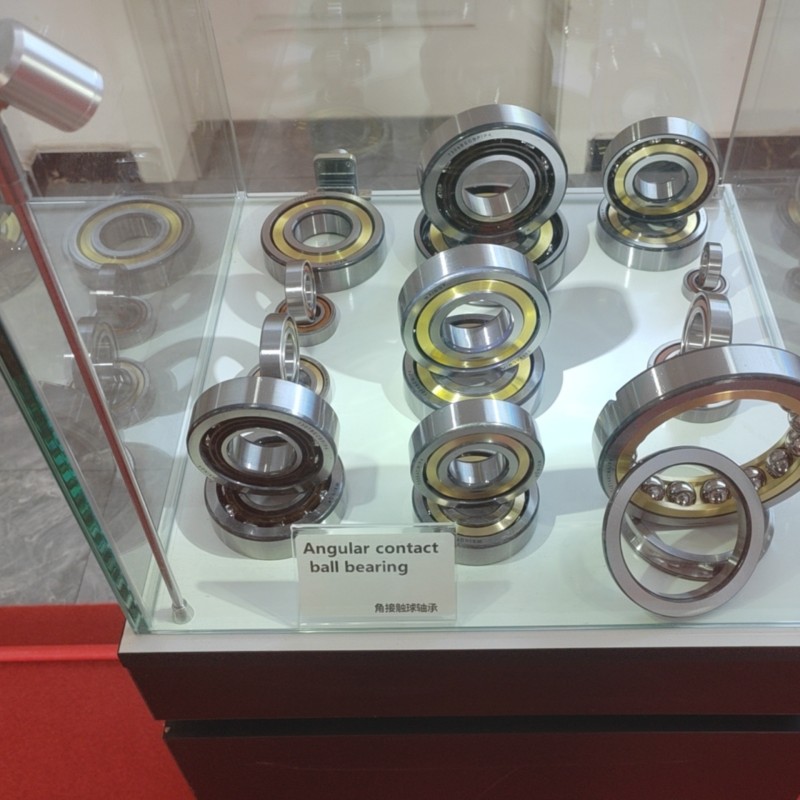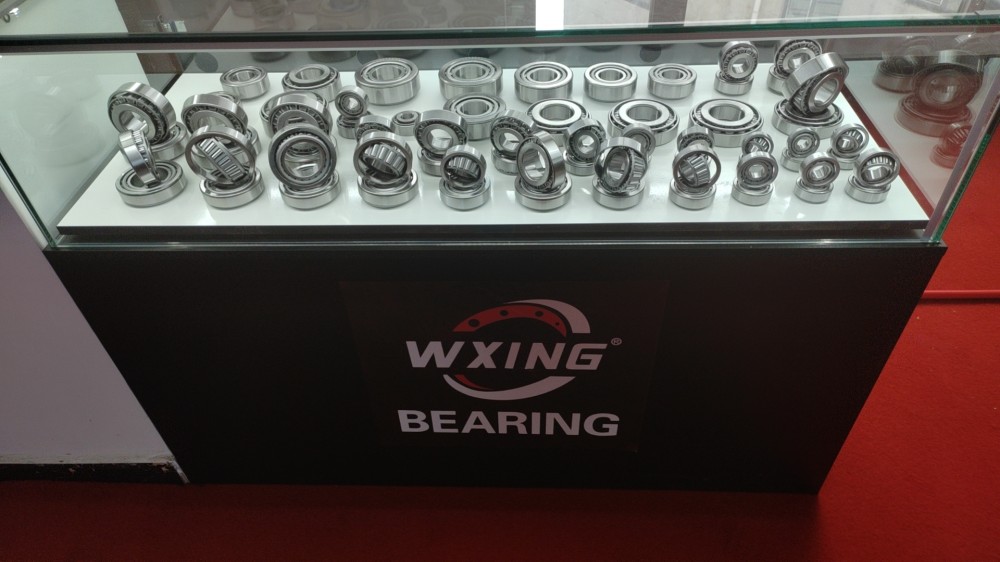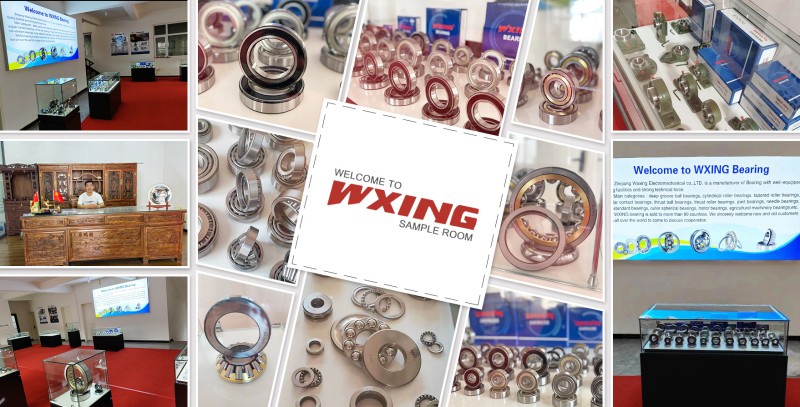CONTACT US
Zhejiang waxing electromechanical co.LTD.,Factory located in Shandong,Headquarters located in Zhejiang,China.
Bearings are divided into radial bearings and thrust bearings according to the bearing direction or nominal contact angle.
According to the type of rolling element, it is divided into: ball bearings, roller bearings.
According to whether it can be aligned, it is divided into: self-aligning bearings, non-aligning bearings (rigid bearings).
According to the number of rows of rolling elements, it is divided into: single-row bearings, double-row bearings, and multi-row bearings.
According to whether the parts can be separated, they are divided into: separable bearings and non-separable bearings.
In addition, there are classifications by structural shape and size.
This article mainly shares the characteristics, differences and corresponding uses of 14 common bearings.
 1. Angular contact ball bearings
1. Angular contact ball bearings
There is a contact angle between the ferrule and the ball. The standard contact angle is 15°, 30° and 40°. The larger the contact angle is, the greater the axial load capacity is. The smaller the contact angle is, the more favorable it is for high-speed rotation. Single row bearings can Bear radial load and one-way axial load. Structurally, two single row angular contact ball bearings combined on the back share the inner ring and outer ring, which can bear radial load and bidirectional axial load.
Angular contact ball bearings
The main purpose:
Single column: machine tool spindle, high frequency motor, gas turbine, centrifugal separator, small car front wheel, differential pinion shaft.
Double column: oil pump, Roots blower, air compressor, various transmissions, fuel injection pump, printing machinery.
2. Self-aligning ball bearings
Double rows of steel balls, the raceway of the outer ring is an inner spherical type, so it can automatically adjust the misalignment of the shaft caused by the deflection or misalignment of the shaft or shell, and the bearing with a tapered hole can be easily installed on the shaft by using fasteners. withstand radial loads.
self-aligning ball bearing
Main application: woodworking machinery, textile machinery transmission shaft, vertical self-aligning bearing with seat.
3. Spherical roller bearings
This type of bearing is equipped with spherical rollers between the outer ring of the spherical raceway and the inner ring of the double raceway. According to the different internal structures, it is divided into four types: R, RH, RHA and SR. The bearing center is consistent and has self-aligning performance, so it can automatically adjust the shaft center misalignment caused by the deflection or misalignment of the shaft or shell, and can bear radial load and bidirectional axial load.
Spherical roller bearing
Main applications: papermaking machinery, deceleration devices, railway vehicle axles, rolling mill gearbox seats, rolling mill roller tables, crushers, vibrating screens, printing machinery, woodworking machinery, various industrial reducers, vertical self-aligning bearings with seats .
4. Thrust self-aligning roller bearing
The spherical rollers in this type of bearing are arranged obliquely. Because the raceway surface of the seat ring is spherical and has self-aligning performance, it can allow the shaft to have a certain inclination, and the axial load capacity is very large. Radial loads are generally lubricated with oil.
Thrust spherical roller bearings
Main applications: hydraulic generators, vertical motors, propeller shafts for ships, reducers for rolling screws in rolling mills, tower cranes, coal mills, extrusion machines, and forming machines.
5. Tapered roller bearings
This type of bearing is equipped with truncated cylindrical rollers, and the rollers are guided by the large rib of the inner ring. The apex of each conical surface of the inner ring raceway surface, outer ring raceway surface and roller rolling surface intersects on the center line of the bearing in design. on point. Single-row bearings can bear radial loads and one-way axial loads, double-row bearings can bear radial loads and two-way axial loads, and are suitable for heavy loads and impact loads.
Tapered Roller Bearings
Main application: Automobile: front wheel, rear wheel, transmission, differential pinion shaft. Machine tool spindles, construction machinery, large agricultural machinery, gear reduction devices for railway vehicles, roll necks and reduction devices for rolling mills.
6. Deep groove ball bearings
Structurally, each ring of the deep groove ball bearing has a continuous groove type raceway with a cross section of about one-third of the equatorial circumference of the ball. Deep groove ball bearings are mainly used to bear radial loads, and can also bear certain axial loads.
When the radial clearance of the bearing increases, it has the properties of an angular contact ball bearing and can bear alternating axial loads in two directions. Compared with other types of bearings with the same size, this type of bearing has a small friction coefficient, high limit speed, and high precision. It is the preferred bearing type for users when selecting models.
Deep Groove Ball Bearings
Main applications: automobiles, tractors, machine tools, motors, water pumps, agricultural machinery, textile machinery, etc.
7. Thrust ball bearings
It consists of a washer-shaped raceway ring with a raceway, a ball and a cage assembly. The raceway ring that matches the shaft is called the shaft ring, and the raceway ring that matches the housing is called the seat ring. Two-way bearings match the secret shaft of the middle ring, one-way bearings can bear one-way axial loads, and two-way bearings can bear two-way axial loads (neither of them can bear radial loads).
Thrust ball bearing
Main application: automobile steering pin, machine tool spindle.
8. Thrust roller bearings
Thrust roller bearings are used to bear axial load-based shafts, combined warp load, but the warp load must not exceed 55% of the axial load. Compared with other thrust roller bearings, this kind of bearing has lower friction coefficient, higher speed and self-aligning ability. The rollers of the 29000 type bearings are asymmetrical spherical rollers, which can reduce the relative sliding between the stick and the raceway during work, and the rollers are long, large in diameter, large in number and large in load capacity, and are usually lubricated with oil. Grease lubrication is available at low speeds.
Thrust Roller Bearings
Main application: hydroelectric generator, crane hook.
9. Cylindrical roller bearings
The rollers of cylindrical roller bearings are usually guided by two ribs of a bearing ring, and the cage roller and guide ring form an assembly that can be separated from the other bearing ring, which is a separable bearing.
This kind of bearing is easy to install and disassemble, especially when the inner and outer rings are required to be interference fit with the shaft and housing. Such bearings are generally only used to bear radial loads, and only single-row bearings with ribs on both inner and outer rings can bear small steady axial loads or large intermittent axial loads.
Cylindrical Roller Bearings
Main applications: large motors, machine tool spindles, axle boxes, diesel engine crankshafts, automotive gearboxes, etc.
10. Four-point contact ball bearings
It can bear radial load and bi-directional axial load. A single bearing can replace the angular contact ball bearings combined in front or back. It is suitable for bearing pure axial load or synthetic load with a large axial load component. This type of bearing can withstand any direction One of the contact angles can be formed under any axial load, so the ring and the ball are always in contact with the two sides and three points on any contact line.
Four point contact ball bearings
Main applications: aircraft jet engines, gas turbines.
11. Thrust cylindrical roller bearings
It consists of washer-shaped raceway rings (shaft rings, seat rings) with cylindrical rollers and cage assemblies. Cylindrical rollers are processed with convex surfaces, so the pressure distribution between the rollers and the raceway surface is uniform, and can bear unidirectional axial loads. The axial load capacity is large and the axial rigidity is also strong.
Thrust Cylindrical Roller Bearings
Main applications: oil drilling rigs, iron and steel machinery.
12. Thrust needle roller bearings
Separable bearings are composed of raceway rings, needle rollers and cage assemblies, which can be combined with thin raceway rings processed by stamping or thick raceway rings processed by cutting. Non-separable bearings are integrated bearings composed of precision stamped raceway rings, needle rollers and cage assemblies, which can withstand unidirectional axial loads. This type of bearing occupies a small space and is conducive to the compact design of machinery. Only the needle roller and cage assembly are used, and the mounting surface of the shaft and the housing is used as the raceway surface.
Thrust Needle Roller Bearings
Main application: Transmission devices for automobiles, cultivators, machine tools, etc.
13. Thrust tapered roller bearings
This type of bearing is equipped with truncated cylindrical rollers (the big end is a spherical surface), and the rollers are accurately guided by the ribs of the raceway ring (shaft ring, seat ring). The vertices of each conical surface intersect at a point on the center line of the bearing. One-way bearings can bear one-way axial loads, and two-way bearings can bear two-way axial loads.
Thrust Tapered Roller Bearings
The main purpose:
One-way: crane hook, oil drilling rig swivel.
Bidirectional: rolling mill roll neck.
14. Outer spherical ball bearing with seat
The outer spherical ball bearing with seat is composed of an outer spherical ball bearing with seals on both sides and a cast (or stamped steel) bearing seat. The internal structure of the outer spherical ball bearing is the same as that of the deep groove ball bearing, but the inner ring of this kind of bearing is wider than the outer ring, and the outer ring has a truncated spherical outer surface, which can be automatically aligned when matched with the concave spherical surface of the bearing seat.
Main application: mining, metallurgy, agriculture, chemical industry, textile, printing and dyeing, conveying machinery, etc.

Copyright © 2025 Zhejiang waxing electromechanical co.LTD. | All Rights Reserved Design
Hello, please leave your name email or WhatsApp here before chat online so that we won't miss your message and contact you smoothly.